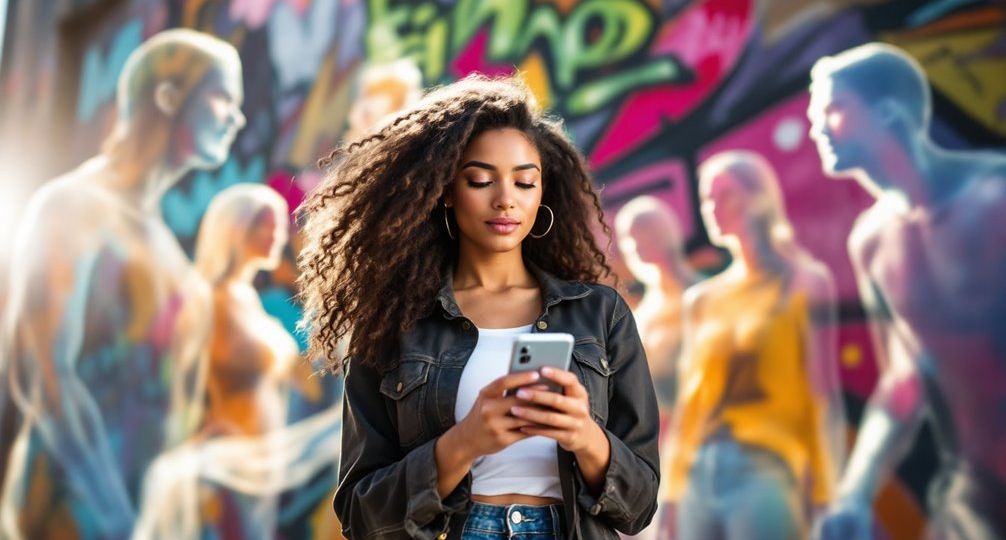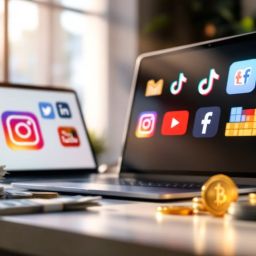
You're traversing the world of influencer marketing and questioning its authenticity. Nearly half of Instagram influencers worldwide have fake followers, with mid-level influencers being particularly prone to fraud. This phenomenon not only skews key performance indicators but also causes substantial financial losses, like the $1.3 billion reported in 2019. As you explore this landscape, consider how these fake followers impact trust and the future of social media marketing. What's truly at stake here?
Key Takeaways
- Nearly half of Instagram influencers globally have fake followers, impacting authenticity.
- Mid-level influencers (50,000 – 100,000 followers) are particularly prone to having fake followers.
- Influencers manipulate engagement numbers, distorting genuine audience interest and metrics.
- Fake followers lead to significant financial losses and erode trust in marketing campaigns.
- Platform regulations and FTC fines penalize influencers with fake followers, emphasizing authenticity.
Prevalence of Fake Followers Among Influencers

How prevalent are fake followers among influencers? Surprisingly, 49% of all Instagram influencers worldwide have resorted to fake followers, raising concerns about influencer authenticity. For mid-level influencers, between 50,000 and 100,000 followers, up to 20% are likely fraudulent. This highlights the critical need for brands to be vigilant. It is crucial for companies to understand fraud trends as part of their effective marketing strategies to prevent financial losses. Fake follower statistics reveal that 24% of influencers manipulate engagement numbers, while over 22% exhibit suspicious growth anomalies. Additionally, more than 60% employ artificial growth methods, complicating genuine engagement tracking. The economic impact is staggering, with a $1.3 billion loss in 2019 due to this fraud. As the influencer marketing market booms, reaching $21.1 billion in 2023, ensuring authenticity remains a priority for innovative brands seeking effective partnerships. Buying followers can be a quick boost to visibility and legitimacy, though it presents ethical considerations for genuine engagement.
Methods Used to Acquire Fake Followers
When you consider purchasing followers from third-party services, remember that companies like Devumi sold over 200 million fake followers before their shutdown, highlighting the scale and accessibility of such tactics. While these services can inflate numbers quickly, they often use bots that don't offer genuine engagement, risking credibility and account integrity. With the prevalence of online social networks and sources of misinformation, it's crucial to understand the impact of these fake follower tactics on the overall integrity of social media platforms. Alternatively, engagement pods, where groups agree to interact with each other's content artificially, can temporarily boost metrics but ultimately distort authentic engagement, making it challenging to assess real audience interest.
Purchasing Followers Services
While the allure of a large follower count might be tempting, purchasing followers services often results in more harm than good. Fake follower services promise rapid results, but they deliver a mix of bots and inactive accounts. These services, lacking ethical considerations, can deceive both the audience and potential brand partners, damaging your credibility. Instagram's algorithms are adept at detecting these anomalies, leading to account suspensions and penalties. Fast delivery and cheap pricing often signal low-quality followers that won't engage with your content, impacting your engagement rates and monetization opportunities. Additionally, services that do not provide real followers can harm your account's integrity and reduce overall interaction. By compromising trust and authenticity, these services pose significant risks to your reputation and potential legal issues. Prioritize genuine growth to maintain integrity and long-term success.
Engagement Pods Strategy
Though engagement pods might seem like a clever way to boost your social media presence, they often create a facade rather than genuine interaction.
Pod dynamics involve influencers banding together to artificially inflate likes and comments. While this may trick algorithms into enhancing visibility, it sacrifices engagement authenticity. Members coordinate through group messages, ensuring immediate engagement on new posts, which algorithms mistakenly perceive as genuine interest.
However, this strategy's predictability—such as identical influencers commenting on every post—can signal fake engagement. Analyzing follower growth and engagement consistency helps detect pod activity. A common indicator of inauthentic following is a sudden increase in follower count, which is often observed in such artificial tactics.
Ultimately, these tactics can harm brand reputation and campaign performance due to the lack of a real audience, undermining true innovation in social media marketing.
Impact on Brands and Influencer Marketing

Influencers with fake followers greatly undermine the effectiveness of brand campaigns. You'll find that these fraudulent accounts distort key performance metrics, leading to wasted marketing spend and diminished brand perception.
When follower counts appear high but engagement is low, it signals deception, eroding audience trust and damaging the brand's credibility. Influencers with audience credibility scores below the threshold of 73.17% tend to achieve lower conversion rates, highlighting the importance of genuine engagement over inflated follower numbers.
- Wasted Resources: Brands pay premium prices for nonexistent audiences, impacting ROI.
- Damaged Trust: High follower counts with low engagement lead to consumer mistrust.
- Economic Implications: Significant ad spend reaches dead audiences, reducing campaign efficiency.
Metrics to Detect Fake Followers
How can you effectively spot fake followers in an influencer's audience? Start with engagement metrics. A genuine account typically showcases a consistent engagement rate of 2-3%. Disproportionate rates can signal suspicious activity. Examine the follower analysis by comparing follower numbers against likes and comments. Sparse interaction often indicates fake followers. Look out for generic comments filled with emojis or repetitive phrases. Use AI tools like HypeAuditor and Collabstr to assess engagement authenticity. Analyze profiles for incomplete information and unnatural follower-following ratios. Fake followers are prevalent, with 49% of Instagram influencers involved in follower fraud as of 2021, which can significantly impact an account's credibility and performance. Behavioral analysis through AI can spot irregular activity patterns and posting frequencies. Finally, content analysis with AI tools evaluates image quality and consistency. This thorough approach guarantees you identify fake followers accurately.
Consequences of Using Fake Followers

When you rely on fake followers, you risk losing credibility, as 88% of marketers prioritize genuine engagement over follower count. Instagram's algorithms actively penalize accounts with low engagement, potentially suspending your account, which aligns with the platform's crackdown on artificial growth. Fake followers don't deliver results because they cannot engage or convert into sales, leading to no real growth. Brands are increasingly cautious, with 53% of them canceling partnerships due to influencer authenticity concerns, highlighting the severe risks to your professional relationships and future opportunities.
Loss of Credibility
Although a large follower count might initially seem impressive, the use of fake followers can severely erode an influencer's credibility. Brands, keen on authenticity, scrutinize follower authenticity and engagement, leading to potential credibility loss and trust erosion. Social media platforms actively remove fake accounts to maintain integrity, and this can further damage an influencer's reputation if they are found to have purchased fake followers.
By partnering with influencers who maintain genuine connections, brands avoid damaging their ROI and reputation. When fake followers are discovered, influencers risk losing valuable collaborations and sponsorships.
- Damages Professional Relationships: Brands prioritize authentic engagements, avoiding influencers with fake followers.
- Affects Brand Partnerships: Sponsorship deals can falter, causing financial setbacks due to credibility issues.
- Undermines Social Proof: Fake followers inflate numbers but fail to engage, damaging perceived trustworthiness.
Ultimately, maintaining genuine interaction is crucial for sustaining an innovative presence in an increasingly scrutinized industry.
Platform Penalties
After recognizing the pitfalls of diminished credibility due to fake followers, it's important to contemplate the tangible repercussions influencers face from social media platforms.
Buying fake followers directly violates the terms of platforms like Instagram and Twitter, leading to strict penalty enforcement. You risk account suspension or even permanent bans, drastically impacting your ability to engage authentically with your audience. Influencers who rely on fake followers also damage their credibility, making it difficult to rebuild trust with brands and followers alike.
The FTC's regulations further compound these penalties, with fines reaching $51,745 per violation for misleading influence metrics.
Historical actions, such as Instagram's purges, show platforms' commitment to cleansing fake accounts. Advanced AI detection and engagement analysis make it harder to evade detection.
Ultimately, these platform penalties hinder growth and innovation, urging influencers to prioritize genuine engagement over artificial amplification.
Brand Partnership Risks
Collaborating with influencers who've fake followers can greatly undermine your brand's marketing strategy. Your marketing dollars are wasted on artificial engagement that fails to deliver a genuine return on investment. This not only affects your immediate budget but also tarnishes your brand credibility by associating it with unreliable influencers. Fake influencers artificially inflate social media presence using deceptive tactics, which means that your marketing dollars are essentially spent on an illusion.
- Wasted Budgets: Fake followers mean marketing dollars don't generate real outcomes.
- Erosion of Trust: Discovering unauthentic influencers damages consumer trust in your brand.
- Challenges in Measuring Success: Metrics become unreliable, complicating strategic decisions.
Without influencer transparency, campaigns struggle to meet objectives, and the intended brand awareness and sales conversions fall short.
As metrics like likes and shares become misleading, your brand's reputation could suffer long-term damage, making it difficult to regain consumer trust.
Importance of Authenticity in Influencer Marketing
In influencer marketing, authenticity isn't just a buzzword—it's a critical factor that can greatly impact the success of your campaigns.
Genuine connections are at the heart of influencer ethics, as 92% of consumers trust recommendations from friends, family, and social media creators. Authentic influencers foster trust by recommending products they're genuinely passionate about. Authenticity is expected to gain more ground over time, driven by the de-influencing trend that emphasizes transparency and relatability.
This transparency in brand partnerships enhances credibility, driving higher engagement and conversions. In fact, 63% of online shoppers are more likely to purchase based on influencer suggestions.
Authentic storytelling and personalized content resonate deeply with audiences, boosting interaction. Use data-driven tools to verify influencer authenticity by analyzing engagement rates and audience demographics.
Avoid inauthentic practices to maintain credibility and foster real, lasting relationships.








